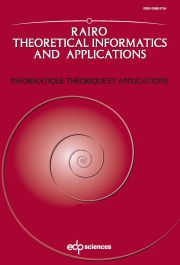Article contents
Existence of an infinite ternary 64-abelian square-free word
Published online by Cambridge University Press: 10 July 2014
Abstract
We consider a recently defined notion of k-abelian equivalence of words by concentrating on avoidance problems. The equivalence class of a word depends on the numbers of occurrences of different factors of length k for a fixed natural number k and the prefix of the word. We have shown earlier that over a ternary alphabet k-abelian squares cannot be avoided in pure morphic words for any natural number k. Nevertheless, computational experiments support the conjecture that even 3-abelian squares can be avoided over ternary alphabets. In this paper we establish the first avoidance result showing that by choosing k to be large enough we have an infinite k-abelian square-free word over three letter alphabet. In addition, this word can be obtained as a morphic image of a pure morphic word.
- Type
- Research Article
- Information
- Copyright
- © EDP Sciences 2014
References
- 2
- Cited by


